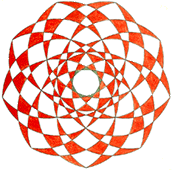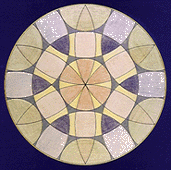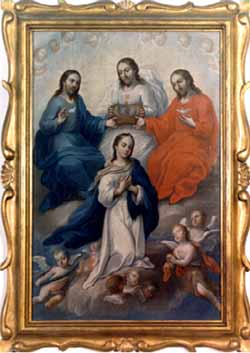|
Praxis für Alternative
Psychosomatik und Traumdeutung, Dr. Remo F. Roth, CH-8001
Zürich
|

|
Remo F. Roth
Dr. oec. publ., Ph.D.
dipl. analyt. Psychologe (M.-L. v.
Franz)
|

|
© 2002-2004
by Pro Litteris, Zurich, Switzerland and Remo F. Roth, Horgen-Zurich. All Rights
Reserved. dr.remo.roth@psychovision.ch.
Republication and redissemination of the contents of this screen or any part of
this website are expressly prohibited without prior psychovision.ch written
consent.
With many thanks to Gregory Sova, Ph.D.
(LA, CA) for
translation assistance
Book Project:
THE RETURN OF THE WORLD SOUL
Wolfgang Pauli, Carl Jung and the Challenge
of the Unified Psychophysical Reality
© copyright 2002-2004 by
Pro Litteris, Zürich. All rights reserved
This book is
intended for private use only, and is copyrighted under existing Internet
copyright laws and regulations.
back
to Chapter 3, part 3
3. Carl Jung's
quaternity, Neoplatonic philosophy and the "potential being" of
Aristotle
(part
4)
Contents:
part1:
3.1
Wolfgang Pauli's criticism at the newly founded
institute
3.2 Carl Jung's "quaternities, projected
into heaven"
part
2:
3.3
Being, nonbeing and potential being
3.3.1
The Assumptio Mariae and the "disinfected" matter in the
heaven
3.3.2 The
coniunctio as the constellated archetype behind the
Assumption
3.3.3 The
coniunctio and Carl Jung's individuation
process
3.3.4 "To
be or not to be" and the Platonic privatio
boni
part
3
(will follow):
3.3.5
The potential being of Aristotle
3.3.6
Complementarity: Particle and wave as potential
being
3.3.7
Pauli's conflict with Jung: The collective unconscious as
potential being
part
4:
3.3.8 "Quaternities projected into heaven" and
the unsolved psychophysical problem
3.3.9 The
spirit of matter, the acausal aspect of the divine world soul
and potential being
3. Carl Jung's quaternity,
Neoplatonic philosophy and the "potential being" of
Aristotle
(part 4)
3.3.8 "Quaternities projected into
heaven" and the unsolved psychophysical problem
In the continuation of his letter to Jung,
Wolfgang Pauli expresses now the following idea:
"Like all ideas, the
unconscious is in both man and nature; ideas have no fixed abode,
not even a heavenly one."
And then he draws the conclusion quoted at
the beginning of this section:
"As long as quaternities are 'projected into heaven' at a great distance
from people... no fish will be caught, the hierosgamos is
absent, and the psychophysical problem remains
unsolved." [translation and emphasis mine]
 As
we remember, Pauli's intention was to show Jung, why he does not
accept the Pope's dogma of the Assumptio Mariae. For him,
Jung's "quaternity projected into heaven" is of course some sort of
Assumption: "Disinfected matter" (the Catholic Holy Virgin Mary) is
taken up in the heavens and there - together with the Holy Trinity -
completes a quaternity. This quaternity is - as the one of the
Christian cross - a (3+1) structure, meaning that three parts are
equal and the fourth is the "totally different" ("das ganze Andere").
Furthermore, because Mary is without any sin, Evil is absent. Matter
is now a "disinfected" Idea in the beyond of the heavens (in the
Empyreum) and therefore the Assumption is a Platonic or Neoplatonic
concept. As
we remember, Pauli's intention was to show Jung, why he does not
accept the Pope's dogma of the Assumptio Mariae. For him,
Jung's "quaternity projected into heaven" is of course some sort of
Assumption: "Disinfected matter" (the Catholic Holy Virgin Mary) is
taken up in the heavens and there - together with the Holy Trinity -
completes a quaternity. This quaternity is - as the one of the
Christian cross - a (3+1) structure, meaning that three parts are
equal and the fourth is the "totally different" ("das ganze Andere").
Furthermore, because Mary is without any sin, Evil is absent. Matter
is now a "disinfected" Idea in the beyond of the heavens (in the
Empyreum) and therefore the Assumption is a Platonic or Neoplatonic
concept.
As we have seen, Jung postulates, that the
structure of the Self, the center of the collective unconscious, is a
quaternity. If
Pauli criticizes this quaternity as a Neoplatonic concept, he says
implicitly that it cannot serve as a model for the unity of matter
and spirit on the background of a monistic psychophysical
reality. As we will
see, this coniunctio oppositorum is the necessary condition
for the definition of the psychophysical reality. Like this we can
now understand Pauli's remark, that the hierosgamos (the
chymic wedding or the coniunctio) is absent in Jung's concept
of the quaternity because it does not include the chthonic aspect of
matter and therefore the psychophysical problem remains
unsolved.
The solution of this problem he sees
prefigured in (Hermetic) alchemy. Therefore he continues:
"But as the alchemists
correctly surmised, matter goes just as deep as the spirit, and I
doubt whether the goal of any development can be absolute
spiritualization."
As we will see, this statement is derived
from the insight of the famous Nobel Laureate, that natural
philosophy of the medieval ages was split in two directions:
Neoplatonic and Hermetic alchemy. The goal of the former one is
exactly this spiritualization of matter with its definition of the "being" in the Platonic heavens, where, on the other hand, Hermetic
alchemy tries to find symmetry between the equally valued spirit and
matter in an in-between world in the middle. Out of this intermediate
realm an actualisation and incarnation of the "potential being" is
possible, which, for Pauli, was the really new aspect of Hermetic
alchemy and of a renewed zeitgeist, in which the
psychophysical reality is accepted as empirically
observable.
3.3.9 The spirit of matter, the
acausal aspect of the divine world soul and potential
being
In October 1953, nine months
after the letter to Jung which included his refusal of the
depth psychologist's "quaternities, projected into heaven", Pauli writes to Markus Fierz
about the same subject: With this statement he protests "against the
Assumption of the Queen".
Pauli guesses that Jung is so fascinated by
the new dogma, because his unconscious is deeply Christian, and this
could be the reason, too, that the blue coat of the Heaven's Queen is
a subject in the latter's book Psychology and Alchemy [CW
12, § 320]. Here Jung uses this symbol as an amplification
for the vertical disc's blue colour of Pauli's World-clock Vision of
1936 [see CW 11, § 111ff.; CW 12, § 307ff.], which
seems itself to be a symbolic description of the constellated
archetype of the coniunctio. After all of what we have seen in
Pauli's writings, we can imagine that he does not like at all this
connection of the blue colour with the Christian heavens, especially
used as an amplification for the interpretation of the vision that
gave him "the impression of most sublime harmony" [CW 11,
§110].
Therefore, he continues by stating that his
Anima - the female part of "his" unconscious that he knows of many
dreams - is much more antique/pagan or Chinese than Christian.
Therefore he looks for amplifications on the blue colour used in
these cultures. He emphasizes that the blue colour, associated with
the female, is of pagan
and chthonic origin. It is the
cornflower of the Greek fertility goddess Demeter. For him, exactly
this fertility is the positive aspect of "mother Earth", which is
constellated in his unconscious. Therefore, it is the "mother earth"
aspect of the feminine that Pauli is in need of integrating into his
psychology. This is the deepest reason why he has such a strong
aversion against the blue coat of the "disinfected" Heavenly Queen.
We know that Wolfgang Pauli was an intuitive
type and therefore had a lot of difficulties with concrete everyday
life and his body. Therefore this positive, i.e. chthonic aspect of
matter, which is fertility for him, is very important. It shows us
where the inferior function, which was the sensation in Pauli's
psychology, could have been creative. As I will show later, the
inclusion of the introverted
sensation (see also link1)
which is related to one's own body could be the solution of
the psychophysical problem, Pauli as well as Jung looked for but did
not yet find.
In connection with this symbolism of the blue
colour in the chthonic fertility cult of Demeter - which is of course
contrary to the sky blue coat of the Christian Heavenly Queen -
Pauli now has a spontaneous association: He remembers earthworms! In
a letter to Marie-Louise von Franz that he wrote six weeks earlier,
he tells her that, in his youth, he liked earthworms very much, in
contrast to insects.
Pauli now brings this fertility symbolism of
the earthworms together with the Logos Spermatikos of the
Stoa. He writes that the latter was the rival of Platonism and
Neoplatonism, and therefore the Stoa invented the "pneuma", the material expression
of the spirit. Then he comes back to the matter-friendly Hermetic alchemists
and stresses that they have always tied to the
Stoa, for example Paracelsus with his "archaeus", his "pneuma" as a
spirit of nature [RFR: which the Medieval physicist guessed to be
located in the region of the stomach!].
Paracelsus' archaeus was a magic principle.
Magic was also the characteristic of the "blue flower" of German
Romanticism. Pauli writes that the magic aspect of this blue flower
consisted in its symbolism of a union of heaven and earth, and he
adds, that like this its content agreed with the tetraktys of
the Pythagoreans.
With these amplifications, Pauli has
corrected Jung's interpretation of the blue colour as a heavenly and
spiritual principle. For him this colour belongs much more to the
chthonic world, to fertility of matter, to the Logos Spermatikos, to
the archaeus of Paracelsus, to the pneuma as a spirit
of matter, and to some sort of magic that belongs to a union of the
spiritual and the material principle.
With this argumentation, Pauli has again
attacked the Neoplatonic concept of the Assumptio Mariae with
its "disinfected Queen in the Heaven", who should, in Carl Jung's
quaternity, play the role of the unitary
counterpart of the male Trinity.
At the end of the letter, Pauli briefly looks
back to the 17th century, to the beginning of natural science with
Galilei and Kepler, and mentions that this was the time in which the
acausal principle disappeared into the unconscious. As we can see in
an earlier letter to Fierz, it was the principle of the medieval
world soul (anima mundi) that was repressed, when mathematics
entered natural philosophy (see Wolfgang
Pauli und die Wiederkehr der Weltseele).
This acausal principle of the anima mundi was of extreme
importance for Pauli. He writes that it is
"dasjenige ..., was sich
der geistigen, gesetzmässigen (= 'lichten') Ordnung
zunächst entzieht. Das ist das Böse im Ethischen
(Problem der Integration des Bösen in die Gottheit, etc.),
das Akausale in der Naturphilosophie.
English translation:
"the one that withdraws an
intellectual order of laws. It is the evil in ethics (the problem
of the integration of evil into the godhead, etc.), the acausal in
natural philosophy." [translation mine]
The Fludd/flood synchronicity (see
Chapter
2) has shown us, that science should
- on a higher level - return to the findings of Robert Fludd. We can
guess now, that this recourse must have something to do with a
return of the world
soul in our times.
Pauli felt this need. After the remark that
as of yet we do not know if this acausal principle is just a "blind
chance" without any teleological meaning, as in quantum physics, he
brings this dark principle together with parapsychology and biology.
And in the above-mentioned letter to Fierz we see that he was
convinced that it was the psychokinetic Pauli effect, which showed
the return of the magic aspect of the world soul.
The act of measurement, the central procedure
of quantum physics, produces a result that is not foreseeable. This
means that quantum physics is acausal or indeterministic. Therefore
we can say that every quantum physical measurement is an act of
creation, an incarnation of potential being into concrete being in
our world, limited by space and time.
There we see the deeper reasons for Pauli's
preference for the earthworms, which reminded him - as a spontaneous
association to the blue colour of Demeter - about the fertility of
organic matter. Fertility is the necessary condition for creation and
incarnation. And such an acausal incarnation takes place out of the
potential being, which is, as we will see, the so-called unus
mundus with its energetical principle, the world-soul (anima
mundi) .
Chapter
4, part 1
See also further articles about
Wolfgang Pauli in
http://www.psychovision.ch/rfr/roth_e.htm
back

25.2.2003
|